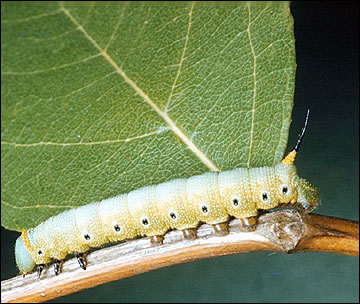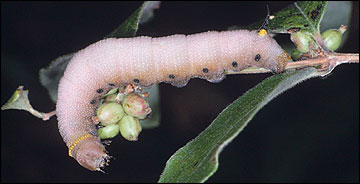Clearwinged sphinx
Hornworms
 Clearwinged sphinx caterpillars (Hemaris diffinis) are present from April to September. They produce two generations per year.
Clearwinged sphinx caterpillars (Hemaris diffinis) are present from April to September. They produce two generations per year.

The color forms for full-grown clearwinged sphinx caterpillars (up to 2 inches long) appear to be pale green to light or dark brown. The body surface is covered with a light colored granulation. However, just behind the head (first thoracic segment) there is a transverse double row of large bright yellow granules going from one side of the body to the other. The spiracles are conspicuous and are outlined in black. The horn at the end of the body is long and slender with a black tip and a bright yellow base; the horn may be shed during development. There are no other markings (lines, patches, etc.) on the body. Known hosts include buckbrush or coral berry, honeysuckle, snowberry and horse gentian. Adult moths are sometimes called the bumblebee sphinx moth because of their appearance or the snowberry clearwing.
About the family
Many caterpillar species in the Sphingidae family are referred to as hornworms because they have a conspicuous horn or spine on the top of the last abdominal segment. The bodies of these caterpillars are usually free of hairlike setae and smooth except for shallow wrinkles in each segment. Adults are referred to as sphinx, hawk or hummingbird moths. They are fast, strong fliers with a rapid wing beat and often hover in front of a flower to feed on the nectar in much the same manner as a hummingbird (and superficially they look like a hummingbird too!). The name sphinx is probably in reference to the sphinx-like position that some of the caterpillars assume when disturbed. Some common vegetable, tobacco and other plant pests belong to this family of caterpillars.